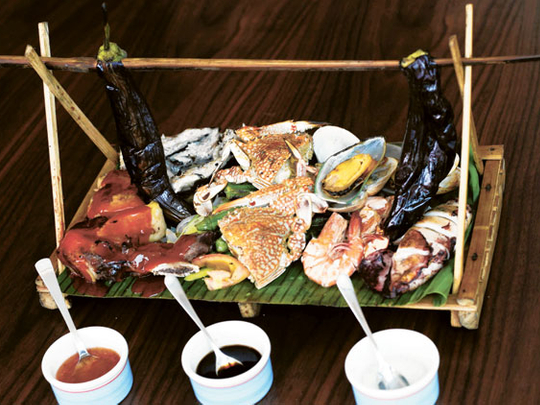
DUBAI: Every time non-Filipino friends ask me to define Filipino food, a standard answer seems to get stuck at the tip of my tongue. It's much easier to define it by what it's not - not burgers and fries or fish 'n' chips, for sure.
My Emirati colleague, Ahmed Ramzan, was curious to get a satisfactory answer to this question, too. So when Ahmed was assigned as my dining partner to sample the expanded Barrio Fiesta at Dubai's BurJuman mall for a review, I got excited.
This chain of mid-range restaurants, founded in 1952, is home of authentic Filipino cuisine with a number of branches in US cities and now in Dubai, too, in addition to the 50-plus outlets scattered all over the Philippine archipelago. You can also find it at Abu Dhabi Mall, and soon, at Dubai's Al Ghurair City.
It being Good Friday (a day of fasting among the mostly-Catholic Filipinos), I thought the place would be quiet. I was wrong: It was packed, perhaps evidence enough that Filipinos always find a reason to celebrate.
Ahmed delighted in his green-mango shake. I suggested green mussels smothered in garlic sauce for starters. The gravy was great and the green mussels (imported from another Asian country) a bit chewier than the ones I've come to love from Cavite fish farms, but I'm not complaining. I washed it down with Sago't Gulaman, a sweet dark concoction with taro pearls and gelatine bits.
For the main course, we tried the Sinalab, a special Visayan (central Philippines) dish made of a healthy mix of slow-cooked seafood (deboned milkfish, shrimps, shellfish, clams, crabs) and meat grilled to perfection, along with rice served in earthenware. It took about 20 minutes but was worth the wait. All the fresh ingredients came flaming hot. I found the portion more than enough for two. The chopped green mangoes made one ask for more.
But at this point, our tummies were starting to say "enough".
Our hosts insisted on picking our choice for dessert on the menu. Mine was Buko Pandan with young coconut strips and pandan essence; Ahmed had Turon a la Mode, ripe fried "saba" (tropical) banana with a scoop of sorbet, laced with choc sauce.
Were these enough to define Filipino food for him already? "It's more than enough," said Ahmed.
But we hadn't even tried the oodles of noodles yet, of which there are about a dozen types, lumpia (spring rolls), the kare-kares (peanut-based satay-type dish), sinigang (tamarind-based soup) and the numerous regional dishes spanning the entire breadth of the 7,107 islands, from Batanes to Tawi-Tawi.
Ahmed said: "Every country and every culture has its own taste. It is the same rice, same fish on the plate, but the taste is totally different - but just as delightful."
The Barrio Fiesta in BurJuman is justifiably more Filipino than the ones I've seen elsewhere - the half-cut coconut husk serving trays, the clay pots, the mother-of-pearl entrance, the lighting and wall decor. I like the nylon acoustic guitar, too, which any customer can pick up to break into a "harana" (traditional Filipino love song) or take Facebook snaps.
This gastronomic treat wasn't too bad for about Dh250. Lunch buffets, for Dh49, are extremely popular on weekends, as with most of the a la carte dishes on the menu. A package lunch special is from Dh26 to Dh28, popular even among non-Filipino expatriates.
It just made the task of defining authentic Filipino food so much easier for me.








